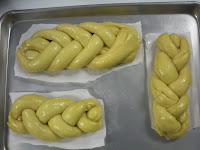 |
| One of our three strand loaves |
Challah is a braided Jewish bread that was usually eaten on the Sabbath. In America it is eaten much more frequently and after making it I know why, It's so delicious. Challah is very rich and has a thin crust that is just enough to give the bread the "browned" flavor. The crumb is soft but substantial and is slightly sweet
. This richness is due to the use of eggs, egg yolks, and honey in the making of the dough. An even richer version known as Berne Brot substitutes milk and butter for the oil and water, but this would make the bread not
parve. Which would interfere with the traditional laws of Kashrut or kosher and could not be consumed at any meal that meat was consumed at.
The challah was one of the most straight forward breads that we have created and it had wonderful results. First, a sponge of flour, water, and yeast was mixed and allowed to rise for 30 minutes. Meanwhile the other ingredients were gathered. These included flour, sugar, salt, honey, water, whole eggs, egg yolks, and vegetable oil. Once the sponge had risen all of the ingredients were mixed and then the kneading began. This dough was so stiff it took alot of kneading. It is better to work with a partner or your hands will be very sore. Once the bread had been kneaded enough to develop the gluten so it could pass a window pane test, the bread was allowed to proof for 75 minutes.
 |
| Berne Brot, featuring the Windsor Knot |
After this came the most difficult part, the dough had to be divided in to equal portions (use a scale for this) before being rolled in to logs. The dough is very stiff and does not want to be stretched, the best way to accomplish this is to use a spray bottle and spritz the work place. The low hydration rate in this dough keeps it from sticking on the table top but a little but of water will help that. The best method is to roll out one strand and once it starts resting move to a second one, repeat this until you are back at the first strand. Continue this cycle of rolling and resting until all strands are at your desired length. We then used a three and a five strand braid to make our loaves, which are allowed to proof
 |
| Unbaked loaves with egg wash |
after being braided. There are a multitude of ways to braid the challah including: the Windsor knot above, a stacked five and three strand braid, the traditional 6-strand, a special 12-strand and any number in-between. This is where you can get creative and make your signature design. Just before baking an egg wash is used to paint the tops of the loaves. This creates an nice shine and browns more than the dough itself so this creates a nice contrast where the braids separate. This is a wonderful bread and if you can keep from eating it all the first day it would be fantastic as french toast.



No comments:
Post a Comment